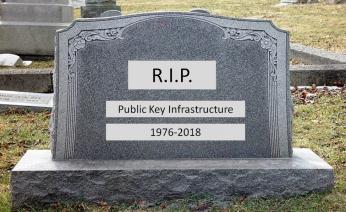You are currently viewing SemiWiki as a guest which gives you limited access to the site. To view blog comments and experience other SemiWiki features you must be a registered member. Registration is fast, simple, and absolutely free so please,
join our community today!
It was 1976 when distinguished scholars Whitfield Diffie and Martin Hellman published the first practical method of establishing a shared secret-key over an authenticated communications channel without using a prior shared secret. The Diffie-Hellman methodology became known as Public Key Infrastructure or PKI.
That was… Read More
I have a lot of friends in the real estate industry, and two of the most common sales tactics are to create “curb appeal,” and to “stage” the interior of the residence being sold. Curb appeal, of course, refers to making the home looks as appealing as possible upon first impression. Update the landscaping. Add flowers. Make sure the… Read More
It’s been 32 years since the successful sci-fi comedy, Back to the Future, saw 17-year old Marty McFly – played by Michael J. Fox – accidentally travel 30 years back in time to 1955. The film was a box-office smash, as audiences worldwide delighted in McFly’s antics, only to soon realize that the cool kid from the future was jeopardizing… Read More
Public-key crypto-systems rely these days on approaches founded in mathematical methods which are provably hard to crack. The easiest to understand requires factorization of a key based on the product of two large prime numbers. Much has been made recently of the ability of quantum computers to crack this style of encryption.… Read More
On Monday Synopsys announced that it was acquiring Elliptic Technologies. They have one of the largest portfolios of security IP consisting of both semiconductor IP blocks and software. Increasingly, security requires a multi-layer approach involving both secure blocks on the chip and a software stack on top of that.
Elliptic’s… Read More
Last month I was on my way to write a detailed article on important aspects to look at while designing an SoC. This was important in the new context of modern SoCs that go much beyond the traditional power, performance and area (PPA) requirements. I had about 12-13 parameters in my list that I couldn’t cover in one go, so I put the write-up… Read More
The Internet of Things (IoT) is arguably the most hyped concept since the pre-crash dot-com euphoria. You may recall some of the phrases from back then such as “the new economy,” “new paradigm,” “get large or get lost,” “consumer-driven navigation,” “tailored web experience,” “it’s different now,” among countless other media… Read More
In today’s world, the three pillars of security are confidentiality, integrity (of the data), and authentication (i.e. “C.I.A.”). Fortunately, Atmel CryptoAuthentication crypto engines with secure key storage can be used in systems to provide all three of these.
Focusing on the confidentiality pillar, in a symmetric system… Read More
The good news about the recently-revealed BadUSB is that there actually is a cure: Hardware crypto engines were invented to protect software, firmware and hardware from exactly these types of attacks, among many others. These uber-tiny, ultra secure hardware devices can be easily and cost-effectively added to USB sticks (and… Read More
Due to increasing proliferation of sensors in our everyday lives, evolution of IoT is natural. The mix of different building blocks with different speed-power-performance constraints makes IoT as the hottest upcoming application area for semiconductor IP vendors. The System-on-Chips (SoCs) coming up in this area typically… Read More




